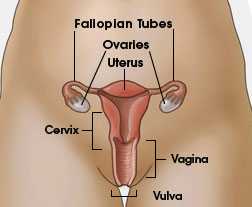Ovarian Cancer

Cancer is a disease in which abnormal cells in the body grow out of control. Cancer is always named for the part of the body where it starts, even if it spreads to other body parts later.
Ovarian cancer is a group of diseases that originates in the ovaries, or in the related areas of the fallopian tubes and the peritoneum. Women have two ovaries that are located in the pelvis, one on each side of the uterus. The ovaries make female hormones and produce eggs. Women have two fallopian tubes that are a pair of long, slender tubes on each side of the uterus. Eggs pass from the ovaries through the fallopian tubes to the uterus. The peritoneum is the tissue lining that covers organs in the abdomen.
Ovarian cancer causes more deaths than any other cancer of the female reproductive system. But when ovarian cancer is found in its early stages, treatment works best. Ovarian cancer often causes signs and symptoms, so it is important to pay attention to your body and know what is normal for you. Symptoms may be caused by something other than cancer, but the only way to know is to see your doctor, nurse, or other health care professional.
Some mutations (changes in genes) can raise your risk for ovarian cancer. Mutations in the breast cancer susceptibility genes 1 and 2 (BRCA1 and BRCA2), and those associated with Lynch syndrome, raise ovarian cancer risk. The Know:BRCA tool can help you understand your risk of having a BRCA gene mutation.
Next: Basic Information
Featured Resources
 Our ovarian cancer fact sheet explains who gets ovarian cancer and lists symptoms and risk factors.
Our ovarian cancer fact sheet explains who gets ovarian cancer and lists symptoms and risk factors.
 The Institute of Medicine issued Ovarian Cancers: Evolving Paradigms in Research and Care with support from CDC.
The Institute of Medicine issued Ovarian Cancers: Evolving Paradigms in Research and Care with support from CDC.
 This infographic explains what young women need to know about hereditary breast and ovarian cancer.
This infographic explains what young women need to know about hereditary breast and ovarian cancer.
 Terri makes it her mission to help women who have or are at risk for ovarian cancer. Read her story.
Terri makes it her mission to help women who have or are at risk for ovarian cancer. Read her story.
 “Listen to your body; don’t assume that it’s just nothing,” says ovarian cancer survivor Tiffany.
“Listen to your body; don’t assume that it’s just nothing,” says ovarian cancer survivor Tiffany.
 Uterine and ovarian cancer survivor Jenny Allen shares her story in this candid video.
Uterine and ovarian cancer survivor Jenny Allen shares her story in this candid video.
- Page last reviewed: September 13, 2017
- Page last updated: September 13, 2017
- Content source:


 ShareCompartir
ShareCompartir